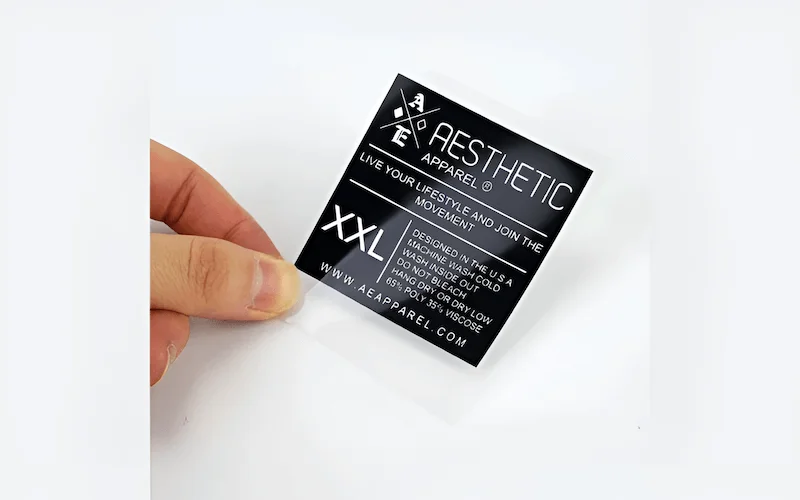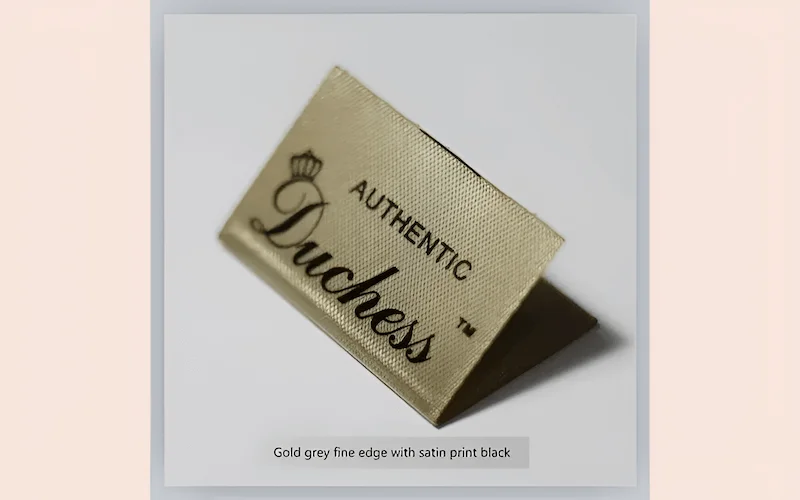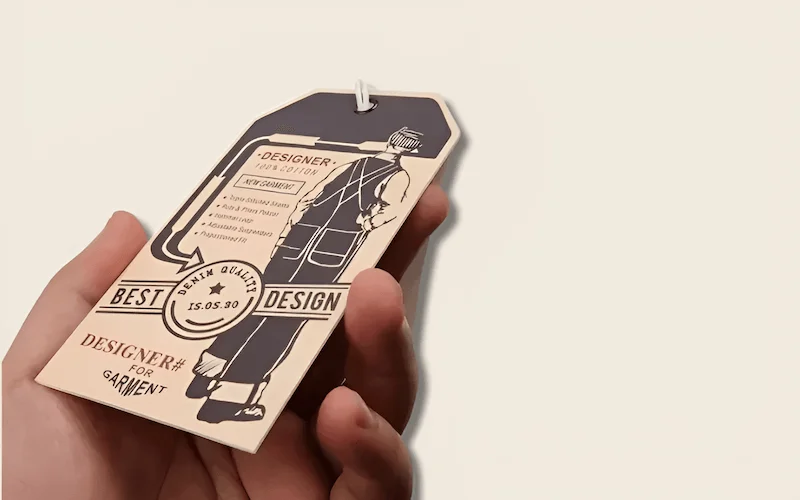Right Print Method: Key to Apparel Branding Success
Printing Technologies refer to the diverse set of mechanical, chemical, and digital processes used to transfer ink, toner, or other substances onto a substrate, thereby reproducing images or text. Far more than just putting ink on paper, this field encompasses everything from centuries-old techniques like offset lithography to cutting-edge methods like digital and 3D printing.
Understanding these technologies is crucial for anyone involved in design, manufacturing, marketing, or simply curious about how the printed materials we interact with daily come into existence. Let’s define these technologies and explore their core types and applications.
1. Why the printing method matters for your apparel brand’s success
Selecting the right printing technique for your labels, tags, and packaging is more than just an aesthetic consideration; these choices significantly influence brand perception and operational efficiency. High print quality on a hang tag can subconsciously communicate premium value, while faded or easily damaged print suggests lower standards.
For items like care labels, durability is a functional necessity – washable labels must withstand repeated laundering without losing crucial information. Financially, different print methods have varying budget implications; some involve substantial initial setup costs but offer cost-effective per-unit prices at high volumes, while others are better suited for smaller batches.
Furthermore, material suitability is key; certain fabrics or packaging films (substrate compatibility) simply adhere better or look superior with specific printing technologies. Making an informed decision balances visual appeal, functional requirements, material compatibility, and cost-effectiveness, ultimately impacting your brand’s presentation and bottom line.
1.1 Offset printing (lithography): Precision for high-volume paper goods
Offset printing, technically known as Lithography, is a widely used technique particularly suited for high-volume printing on paper-based materials. The process involves transferring ink from dedicated printing plates (usually metal) to a rubber blanket, and then offsetting this image onto the final paper surface.
This indirect transfer results in consistently high-quality, sharp images and text. A major strength is its exceptional color accuracy, easily replicating specific shades using the Pantone Matching System (PMS). For apparel brands, offset printing is ideal for large runs of primary hang tags, lookbooks, or promotional cards where brand color consistency is paramount.
- Pros: Excellent image quality and detail, superb color matching, very cost-effective (at scale) for large quantities.
- Cons: High initial setup cost due to plate creation, less economical for short runs, primarily limited to paper goods and cardstock.

1.2 Digital printing: speed, flexibility & variable data
Digital printing encompasses methods like Inkjet printing and Laser printing, where digital files are sent directly to the printer without the need for plates. This direct process is its core advantage, offering remarkable speed and flexibility, especially for short print runs.
Key benefits include minimal to low setup cost, fast turnaround times, and the powerful capability for variable data printing (VDP). VDP allows elements like text or images to be changed from one printed piece to the next without stopping the print run – perfect for personalized labels such as sequentially numbered tags, or printing size and SKU variations (S, M, L, XL) within a single batch.
Digital printing is an excellent choice for small business needs, enabling brands to create prototypes, test designs, or order only the quantities needed.
- Pros: Low or no setup cost, fast for short runs, ideal for variable data/personalization, cost-effective for small quantities.
- Cons: Unit cost may be higher than offset for large volumes, potential limitations in color matching compared to PMS (though quality is constantly improving), durability on certain materials might require specific ink/finishing considerations.
1.3 Flexographic printing (flexo): the go-to for packaging & roll labels
Flexographic printing, commonly called Flexo, utilizes flexible photopolymer plates mounted on rotating cylinders. The raised image on the plate picks up ink and transfers directly onto the substrate (the material being printed on).
Flexo shines in high speed production, particularly on non-porous packaging materials like plastics and films, making this method a standard for poly mailers, branded shopping bags, and labels supplied on rolls (roll labels). The process uses fast-drying inks, contributing to its efficiency. While capable of good quality, achieving the ultra-fine detail of offset might be more challenging.
- Pros: Excellent for packaging materials (substrates like plastic, film), very high speed for long runs, produces durable inks suitable for packaging, versatile material compatibility.
- Cons: Requires setup costs for creating plates (tool costs), fine detail reproduction might be slightly less sharp than offset, changes require new plates.

1.4 Screen printing: unmatched durability for textiles & bold designs
Screen printing works by pushing ink through a mesh screen onto the substrate, using a stencil to block areas where ink shouldn’t pass. Its primary strength, especially relevant for apparel, lies in the exceptional durability of the ink deposit, leading to excellent wash resistance on fabric labels.
This method allows for thick layers of ink, resulting in highly vibrant colors and opaque inks (like bright white on dark fabric) that possess a distinct, often slightly raised tactile effect. Screen printing is ideal for printed fabric labels (care labels, brand labels sewn into garments), direct-to-garment printing elements, and tags requiring bold, solid color graphics.
- Pros: Outstanding durability and wash resistance on textile materials, creates vibrant and opaque colors, versatile across many materials including fabrics, creates noticeable tactile finishes.
- Cons: Higher setup cost (per color) as each color requires a separate screen, can be less cost-effective for multi-color designs in short runs, may struggle with reproducing very fine photographic detail compared to offset or digital.
1.5 Quality & detail
Comparing the typical print quality outcomes:
- Offset & High-End Digital: Offer the highest potential for sharpness and fine detail, reproducing intricate graphics and small text with clarity. Ideal for main branding elements where precision matters.
- Screen Printing: Excels in color vibrancy and opacity, particularly on challenging surfaces like textiles. Best suited for bold graphics and achieving high durability rather than fine photographic detail.
- Flexography: Optimized for speed and functionality on packaging substrates. Delivers good image reproduction suitable for logos and required information on items like poly mailers, though perhaps less sharp than offset for complex imagery.
1.6 Material compatibility
Choosing the right print method often depends on the material (substrate). Here’s a general guide:
| Material | Best/Common Printing Technologies |
|---|---|
| Paper / Cardstock | Offset Printing, Digital Printing |
| Fabric (Cotton, Satin, Poly) | Screen Printing, Specialized Digital Textile Printing, Heat Transfer |
| Plastic Film / Poly Mailers | Flexographic Printing, some specialized Digital Printing |
This table highlights common pairings for optimal results regarding material compatibility. Always confirm specific capabilities with your print provider, as advancements continually expand options for different textiles, plastic, and film types.

1.7 Cost dynamics
Understanding cost dynamics is crucial for budgeting. The main factors are setup costs and unit cost relative to print volume:
- Offset, Flexo, Screen Printing: Involve higher initial setup costs due to the creation of plates or screens. However, once set up, the cost per printed piece (unit cost) decreases significantly as print volume increases (economies of scale). These methods are generally more cost-effective for medium to large runs.
- Digital Printing: Typically has very low or no specific setup costs. The unit cost tends to remain relatively consistent regardless of volume. This makes digital highly cost-effective for short runs, prototypes, and variable data jobs, but potentially more expensive per piece than traditional methods for very large quantities. Aligning the method with your expected budget and order size is key.
1.8 Order volume & speed
Order volume and required turnaround time heavily influence technology choice:
- Digital Printing: Ideal for low order volume, short print runs, or when needing variable data. Offers the fastest setup, making quick turnaround time possible for small batches.
- Offset, Flexo, Screen Printing: Better suited for medium to long print runs (production volume). While initial setup takes longer, the actual print speed during the run is often much faster than digital, especially for Flexo. This makes them efficient for large, consistent orders once production begins.
1.9 Durability needs
Durability requirements vary significantly:
- Fabric Labels: Require high wash resistance (washfastness). Screen printing is generally considered the leader here due to the thick, resilient ink layer that bonds well with textiles. Specialized ink durability options exist for other methods but screen printing often provides the benchmark for longevity through washing and wear-and-tear.
- Hang Tags: Need to withstand handling but not washing. Most methods offer sufficient durability, with coatings potentially adding extra protection.
- Packaging (Poly Mailers): Requires resistance to scuffing, moisture, and handling during transit. Flexography typically uses durable inks formulated for these conditions.
- Lightfastness (resistance to fading from light) can also be a factor for inks used on items exposed to display conditions.
2. Smart choices for small clothing businesses & startups
Navigating printing options can feel overwhelming for startups and small business needs. Here are some practical tips:
- Handle MOQs Smartly: Many traditional printers have Minimum Order Quantities (MOQs). If these are too high initially, ask about combining your order with others, explore group buys, or start with digital printing (for testing) which often has no or very low MOQs.
- Leverage Digital Early On: Use digital printing for initial product launches, market testing, and creating prototypes. The low setup cost and flexibility for short runs minimize risk and allow for easy design adjustments.
- Plan for Scaling Up: As your volume grows, anticipate when transitioning to offset (for paper goods), flexo (for packaging), or screen printing (for fabric labels) might become more cost-effective. Discuss this growth path with potential print partners.
- Always Get Samples/Proofs: Before committing to a large run, request samples or proofs. This could be a digital proof (PDF showing layout), a press proof (a sample from the actual press), or ideally, a sample printed on your exact chosen material. This step is crucial for verifying color, quality, and material compatibility, preventing costly mistakes.
3. Related questions
Which printing method is most durable for wash-and-wear fabric labels?
For maximum durability and washfastness on fabric labels intended for clothing, screen printing is generally the preferred method. The process lays down a robust layer of ink that adheres well to textile fibers and withstands repeated washing and drying cycles effectively.
While specialized inks enhance the wash resistance of other methods like digital textile printing, screen printing remains a benchmark for longevity in harsh conditions.
Can I get samples before placing a full order?
Yes, obtaining samples or proofs before a full production run is highly recommended and usually possible. Depending on the printer and method, you might receive digital proofs (for layout confirmation), press proofs (calibrated samples from the actual equipment, often incurring a cost), or physical samples printed on your chosen material.
Discuss proofing options with your print provider; this step is vital for ensuring the final product meets expectations.
What’s the best way to print vibrant colors on dark poly mailers?
Flexographic printing is commonly used for poly mailers and is well-suited for achieving vibrant colors, even on dark substrates. Using opaque inks formulated for plastics is key. Depending on the complexity and volume, screen printing could also be an option for achieving high opacity on plastic, though flexography is typically more cost-effective for standard mailer printing. Some advanced digital printing technologies are also developing capabilities for printing effectively on films.
Which printing methods have high setup costs?
Offset printing, flexographic printing, and screen printing generally involve higher initial setup costs. This is because they require the creation of physical components like printing plates (offset, flexo) or mesh screens (screen printing) for each color in the design. In contrast, digital printing typically has very low or no specific setup costs because the image is transferred directly from a digital file.
Read more:
Choosing the right printing technologies involves balancing factors like order volume, budget constraints, material choice, desired quality, and durability needs. Whether you’re creating intricate hang tags, durable care labels, or eye-catching packaging, understanding the strengths and weaknesses of each method empowers you to make informed decisions that align with your brand vision.
Apply this knowledge to assess your specific requirements for each branded item. Seeking expert consultation can further refine your choices, ensuring your labels, tags, and packaging effectively represent your apparel branding and meet functional demands. Partnering with knowledgeable suppliers, such as those specializing in apparel branding components, can provide invaluable guidance in navigating these options.






















